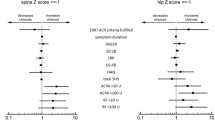Abstract
A prospective study was made to seek for a convenient biomarker to predict progression of bone destruction (PBD) in early stages of rheumatoid arthritis (ERA). All participated patients had definite RA and their radiographic stages were mild less than stage II of the Steinbrocker classification, naïve for treatment of any DMARDs or corticosteroids. After the entry, they were treated according to the 2002 ACR management guideline for RA. The candidate biomarkers (RF-IgM, RF-IgG, CARF, ACPA, CRP, ESR, NTx, MMP-3, IL-6 and osteopontin) were measured at the entry. PBD was assessed radiographically by interval changes in the modified Sharp scores (ΔSHS) for 24 months. The associations between ΔSHS and baseline biomarkers were assessed statistically by multivariate regression analyses. Both the baseline ACPA and IL-6 levels correlated with PBD, suggesting that they could predict PBD in ERA.
Similar content being viewed by others
References
Quinn MA, Conaghan PG, Emery P (2001) The therapeutic approach of early intervention for rheumatoid arthritis: what is the evidence? Rheumatology (Oxford) 40:1211–1220
Smolen JS, Aletaha D, Grisar J et al (2008) The need for prognosticators in rheumatoid arthritis. Biological and clinical mar: where are we now? Arthritis Res Ther 10:208
Arnett FC, Edworthy SM, Bloch DA, McShane DJ, Fries JF, Cooper NS et al (1988) The American Rheumatism Association 1987 revised criteria for the classification of rheumatoid arthritis. Arthritis Rheum 31:315–324
Steibrocker O, Traeger CH, Batterman RC (1949) Therapeutic criteria in rheumatoid arthritis. J Am Med Assoc 140:659–662
Amenrican College of Rheumatology Sucommittee on Rheumatoid Arthritis Guidelines (2002) Guidelines for the management of rheumatoid arthritis. 2002 Update 46:328–346
Dawes PT, Fowler PD, Clarke S, Fisher J, Lawton A, Shadforth MF (1986) Rheumatoid arthritis: treatment which controls the C-reactive protein and erythrocyte sedimentation rate reduces radiographic progression. Br J Rheumatol 25:44–49
van Venrooij WJ, Hazes JM, Visser H (2002) Anticitrullinated protein/peptide antibody and its role in the diagnosis and prognosis of early rheumatoid arthritis. Neth J Med 60:383–388
Young A, Sumar N, Bodman K, Goyal S, Sinclair H, Roitt I, Isenberg D (1991) Agalactosyl IgG: an aid to differential diagnosis in early synovitis. Arthritis Rheum 34:1425–1429
Green MJ, Gough AK, Devlin J, Smith J, Astin P, Taylor D et al (2003) Serum MMP-3 and MMP-1 and progression of joint damage in early rheumatoid arthritis. Rheumatology 42:83–88
Valleassion H, Laasonen L, Koivula MK, Mandelin J, Friman C, Risteli J et al (2003) Two year randomized controlled trial of etidronate in rheumatoid arthritis: changes in serum amino terminal telopeptides correlate with radiographic progression of disease. J Rheumatol 30:468–473
Ohshima S, Yamaguchi N, Nishioka K, Mima T, Ishii T, Umeshita-Sasai M et al (2002) Enhanced local production of osteopontin in rheumatoid arthritis. J Rheumatol 29:979–990
Van der Heijde DM, van Riel PL, Nuver-Zwart IH, Gribnau FW, van de Putte LB (1989) Effects of hydroxychloroquine and sulphasalazine on progression of joint damage in rheumatoid arthritis. Lancet 1:1036–1038
Syversen SW, Gaarder PI, Goll GL, Odegard S, Haavardsholm EA, Mowinckel P et al (2008) High anti-cyclic citrullinated peptide levels and an algorithm of four variable predict radiographic progression in patients with rheumatoid arthritis: results from a 10-year longitudinal study. Ann Rheum Dis 67:212–217
Kudo-Tanaka E, Ohshima S, Ishii M, Mima T, Matsushita M, Azuma N et al (2007) Autoantibodies to cyclic citrullinated peptide 2 (CCP2) are superior to other potential diagnostic biomarkers for predicting rheumatoid arthritis in early undifferentiated arthritis. Clin Rheumatol 26:1627–1633
Syversen SW, Haavardsholm EA, Boyesen P, Goll GL, Okkenhaug C, Gaarder PI et al (2010) Biomarkers in early rheumatoid arthritis: longitudinal associations with inflammation and joint destruction measured by magnetic resonance imaging and conventuinal radiographs. Ann Rheum Dis 69:845–850
Suzuki M, Hashizume M, Yoshida H, Shiina M, Mihara M (2010) IL-6 and IL-1 synergistically enhanced the production of MMPs from synovial cells by up-regulating IL-6 production and IL-1 receptor I expression. Cytokine 51:178–183
Nishimto N, Kishimoto T (2006) Interleukin-6: from bench to bedside. Nat Clin Pract Rheumatol 2:619–626
Smolen JS, Beaulieu A, Rubbert-Roth A, Ramos-Remus C, Rovensky J, Alecock E et al (2008) Effect of interleukin-6 receptor inhibition with tocilizumab in patients with rheumatoid arthritis (OPTION study): a double-blind, placebo controlled, randomized trial. Lancet 371:987–997
Ohshima S, Saeki Y, Mima T, Sasai M, Nishioka K, Shimizu M et al (1999) Long-term follow-up of the changes in circulating cytokines, soluble cytokine receptors, and white blood cells subset counts in patients with rheumatoid arthritis (RA) after monoclonal anti-TNF alpha antibody therapy. J Clin Immunol 19:305–313
Acknowledgments
This work was supported by a Grant-in-Aid for Research of Immunological Disorders from The Japan National Hospital Organization (NHO) and carried out by the iR-net Study Group of NHO. We thank Drs. Yasuda M. and Fujita M. for recruiting the patients and Mr. Yano T. for helping statistical analyses. We also thank Ms. Kitatobe, Ms. Nakata and Ms. Uesugi for their excellent secretarial works.
Conflict of interest
All authors have no conflicts of interest.
Author information
Authors and Affiliations
Consortia
Corresponding author
Rights and permissions
About this article
Cite this article
Saeki, Y., Kudo-Tanaka, E., Ohshima, S. et al. Baseline anti-citrullinated peptide antibody (ACPA) titers and serum interleukin-6 (IL-6) levels possibly predict progression of bone destruction in early stages of rheumatoid arthritis (ERA). Rheumatol Int 33, 451–456 (2013). https://doi.org/10.1007/s00296-012-2397-1
Received:
Accepted:
Published:
Issue Date:
DOI: https://doi.org/10.1007/s00296-012-2397-1




